Topic: Events
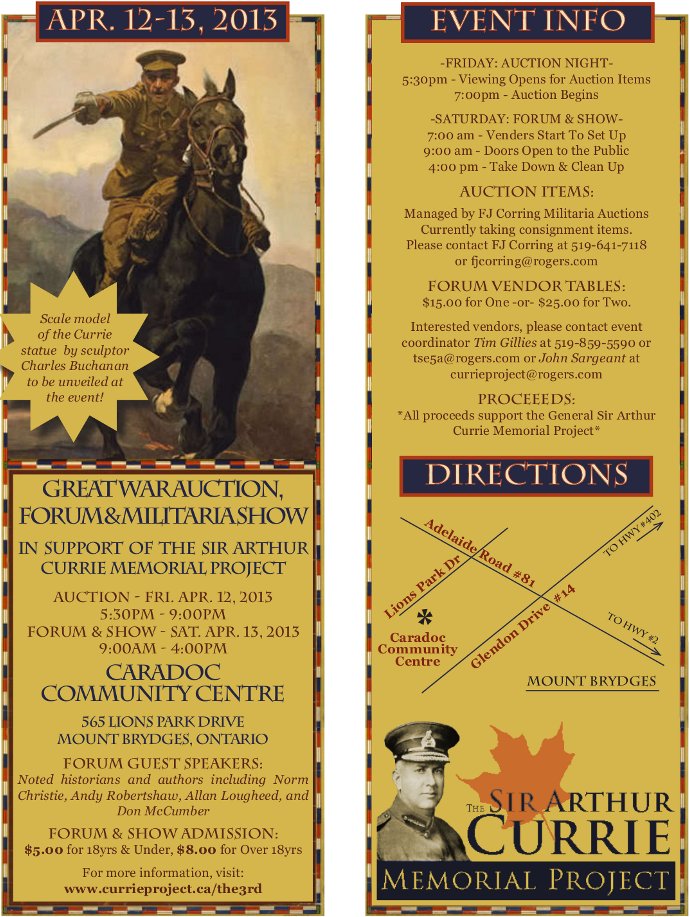


Ottawa, 15th June, 1888
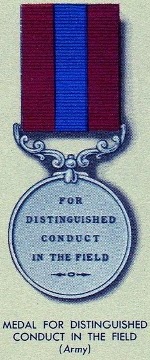 The following Imperial Regulations apply in all cases where medals have been granted to miltiamen in Canada:—
The following Imperial Regulations apply in all cases where medals have been granted to miltiamen in Canada:—
Paragraphs 982, 983 and 984, Royal Warrant, 1887, Part 1, section 6, Rewards, etc.:
982. Every soldier who is found guilty by a Court Martial of the following offences: desertion, fraudulent enlistment, any offence under section 17 or 18 Army Act, 1881, and every soldier who is sentenced by a Court Martial to penal servitude, or to be discharged with ignominy; shall forfeit all Medals and Decorations (other than the Victoria Cross, which is dealt with under special regulations) of which he may be in possession, or to which he may have been entitled, together with any annuity or Gratuity thereto appertaining.
983. Every soldier show:—
(a) is liable on confession of desertion or fraudulent enlistment, but whose trial has been dispensed with;
(b) is discharged in consequence of incorrigible and worthless character; or expressly on account of misconduct; or on conviction by the Civil Power; or on being sentenced to penal servitude, or for giving a false answer on attestation;
(c) is found guilty by a Civil Court of an offence which, if tried by Court Martial, would be cognizable under section 17 or section 18, Army Act; or is sentenced by a Civil Court to a punishment exceeding six months imprisonment;
Shall forfeit all Medals (other than the Victoria Cross, which is dealt with under special regulations) granted to him subsequently to the date of Our Warrant of 25th June, 1881, together with the annuity or gratuity, if any, thereto appertaining.
984. Any General or District Court Martial may, in addition to or withour any other punishment, sentence any offender to forfeit any Medal or Decoration (other than the Victoria Cross, which is dealt with under special regulations), together with the annuity or gratuity, if any, thereto appertaining which may have been granted to him; but no such forfeiture shall be awarded by the Court Martial when the offence is such that the condition does of itself entail a forfeiture under Articles 982 and 983.
Paragraph 12, Section–XX–Medals—The Queen's Regulations and Orders for the Army, 1885:—
12. When Medals are forfeited they are to be transmitted to the Adjutant General for disposal. The same course is to be followed in case of Medals, which may have been recovered after a soldier has been convicted of making away with them. Letters containing Medals when forwarded through the post, are to be registered.
The following text of paragraphs 17 and 18 of the Army Act, 1881 are taken from the 1907 edition of the Manual of Military Law.
17. Every person subject to military law who commits any of the following offences; that is to say,
Being charged with or concerned in the care or distribution of any public or regimental money or goods, steals, fraudulently misapplies, or embezzles the same, or connives at the stealing, fraudulent misapplication, or embezzlement thereof, or wilfully damages any such goods on conviction by court-martial be liable to suffer penal servitude, or such less punishment as is in this Act mentioned.
18. Every soldier who commits any of the following offences; that is to say.
(1.) Malingers, or feigns or produces disease or infirmity or
(2.) Wilfully maims or injures himself or any other soldier, whether at the instance of such other soldier or not, with intent thereby to render himself or such other soldier unfit for service, or causes himself to be maimed or injured by any person, with intent thereby to render himself unfit for service; or
(3.) Is wilfully guilty of any misconduct, or wilfully disobeys, whether in hospital or otherwise, any orders, by means of which misconduct or disobedience he produces or aggravates disease or infirmity, or delays its cure; or
(4.) Steals or or embezzles or receives, knowing them to be stolen or embezzled any money or goods the property of a comrade or of an officer, or any money or goods belonging to any regimental mess or band, or to any regimental institution, any public money or goods; or
(5.) Is guilty of any other offence of a fraudulent nature not before in this Act particularly specified, or of any other disgraceful conduct of a cruel, indecent, or unnatural kind,
shall on conviction by court-martial be liable to suffer imprisonment, or such less punishment as is in this Act mentioned.
 Special Provisions for the Victoria Cross
Special Provisions for the Victoria CrossThe special provisions for the Victoria Cross were provided in the Fifteenth article of the original Warrant for the award, published in the London Gazette on 5 February 1856:
Fifteenthly. In order to make such additional provision as shall effectually preserve pure this most honourable distinction, it is ordained, that if any person on whom such distinction shall be conferred, be convicted of treason, cowardice, felony, or of any infamous crime, or if he be accused of any such offence and doth not after a reasonable time surrender himself to be tried for the same, his name shall forthwith be erased from the registry of individuals upon whom the said Decoration shall have been conferred by an especial Warrant under Our Royal Sign Manual, and the pension conferred under rule fourteen, shall cease and determine from the date of such Warrant. It is hereby further declared that We, Our Heirs and Successors, shall be the sole judges of the circumstance demanding such expulsion; moreover, We shall at all times have power to restore such persons as may at any time have been expelled, both to the enjoyment of the Decoration and Pension.
Her Majesty Queen Victoria reserved the right to determine if any soldier should be required to forfeit the award for valour fashioned in her name.

Among the many items are one that invite the curious readr to explore information that may not be published anywhere else. One example is the report titled "Food Complaints and Cook’s Training Canadian Army Overseas, 1939-1945"
From this brief (11 page) report, we find that the importance of rations for soldiers was well recignized:
"The importance that may be attached to a discussion of food complaints lies in the fact that such complaints have a bearing on Morale. Three "M" factors in Morale—"money", "mail" and "meals"—have an immediate and personal effect on the soldier. Since food is a basic necessity, "meals" in sufficient quantity and of adequate quality are of first importance."
Despite this, the complaints of Canadian soldiers deployed to Britain early in the Second World War shows that that their experience do not live up to expectations. The censoring of letters by military authorities allowed them to also keep watch for signs of morale issues, such as poor rations:
"Many soldiers failed to appreciate the necessity of rationing and there were repeated requests for food parcels from home. Typical comments were: "the rations we get wouldn't be enough to feed a rat" and "our biggest trouble is we cannot get enough [food]". A soldier from a highland regiment complained that the food was insufficient when returning from exercises. There were complaints. to, of the monotony of the diet, such as, "food … nothing fancy but substantial" and "food all right but very monotonous". Complaints about bad food were manifold but tended to be general rather than specific. "Terrible", "unfit for pigs" and "even the dogs won't eat it", were comments in this class, as were "some men claim that the food they get is making them ill", and it [the food] was good when we first landed but now it is getting worse. Sunday … for breakfast … [we had] fish … so rank we couldn't eat it". Some writers realized that the poor quality of the food which was served to them was often due to poor administration and to poor cooking. One soldier, writing in August 1941, and perhaps a little more discerning than his comrade, observed, "our meals have been poor and insufficient since hitting this country mostly because of mismanagement". The complaints of poor cooking are well illustrated by the following: "The food none too good is disgracefully abused by the cooks … " and "the rations isued are alright but the cooks mess it up so much that it is not fit to eat most of the time". (C.M.H.Q. 4/Censor/4/3, Senior Officer, C.M.H.Q. to H.Q. Cdn Corps 22 Sep 41, and Field Censor (Home) Reports, 15 Sep – 12 Oct 41)"
This report records not only complaints by soldiers about the quality and quantity of food they received, but also illuminates the fact that it was a recognized problem that needed to be solved.
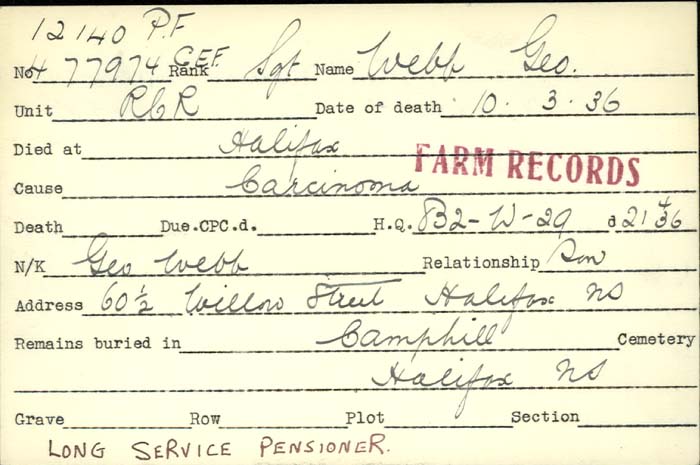 Above is shown the Veteran's Death Card of Sergeant George Webb. A long service soldier and First World War veteran of The Royal Canadian Regiment, George returned to halifax after the War. He continued serving in the Regiment until 1926, when he retired to pension.
Above is shown the Veteran's Death Card of Sergeant George Webb. A long service soldier and First World War veteran of The Royal Canadian Regiment, George returned to halifax after the War. He continued serving in the Regiment until 1926, when he retired to pension.
Library and Archives Canada (LAC) continues to add digital collections to its on-line resources. With the approached centennial of the First World War, and the likely surge in genealogical interest surrounding soldiers of that conflict, it is good to see the new work being done by LAC to make resources available and accessible. Where requests for file copies can take weeks, or months, to get through their work flow for production of photocopies, any efforts they make to digitize and share new material both reduces their workload for simpler request and increases the immediacy of information available to researchers.
Among the newest resources now available are the "Veterans Death Cards" for First World War Soldiers. While casualties of the War were recorded in detail and the information has been available through the Canadian Virtual War Memorial and the Commonwealth War Graves Commission, it has always been more difficult to determine when, where and how a soldier who survived the war later died. This information an often be a key starting point to work through rebuilding the story of his post war life.
The Veterans Death Cards provide that start point. With varying amounts of information, they can provide the location, date and cause of a veteran's death, offering one more point of contact to available information in the research of individual soldiers.
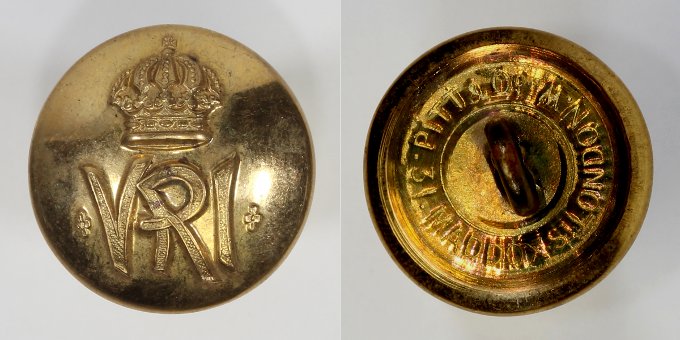
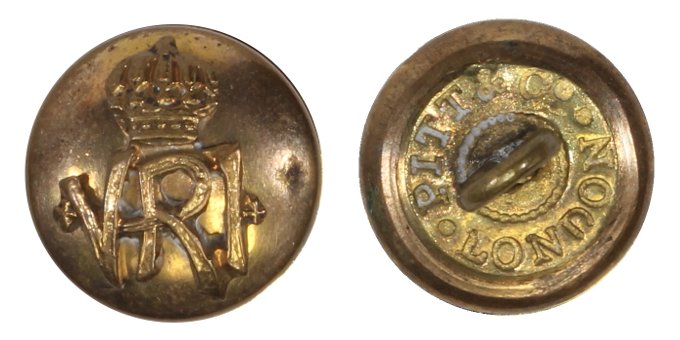
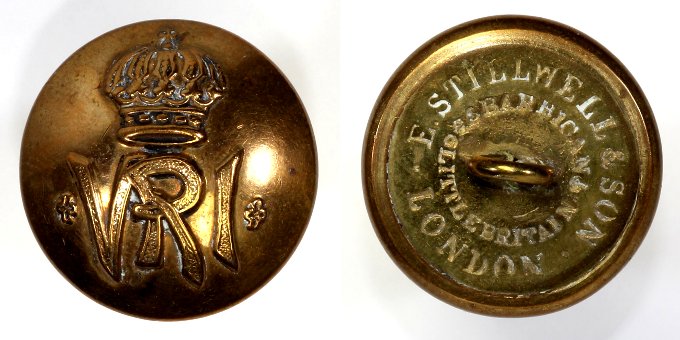
"Edward Stillwell started business about 1825, and it became Stillwell & Son in about 1852. They ceased trading about 1957. An 1881 directory listed them as: "Edward Stillwell & Son, gold & silver lacemen & embroiderers, army & navy outfitters, cork helmet manufacturers & sword cutlers, Manchester & woollen warehousemen, & every description of Masonic clothing, jewels, furniture & fittings, tinsel, lace & trimmings, prize medal 1862 for good execution,25 & 26 Barbican, London EC; 6 Little Britain, London EC; & 29 Savile Row, Regent Street, London W"
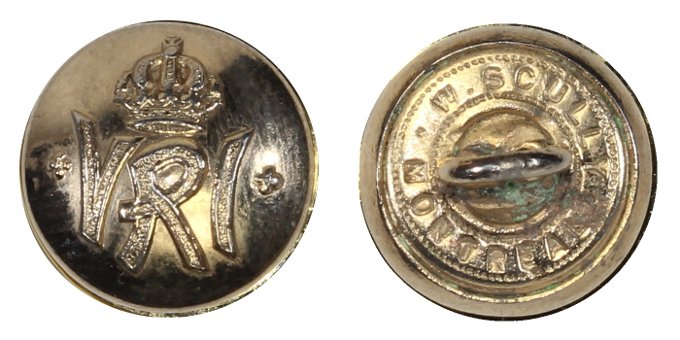
"The firm of William Scully Ltd. earned a special place in Canadian military history by becoming the first firm to produce regulation headdress and badges in Canada. American military manufacturers had always met the needs of their armed services through production in the United States, but with the exception of a few small items on trial, all Canadian Militia and Police headgear and badges had been designed and manufactured in England and imported."
"In 1908 the company moved to University Street, Montreal. The factory was the only one of its kind in Canada, and was then in full operation and able to accept a variety of military and civil contracts for caps and helmets, gold and silver embroidered badges, metal badges, uniform buttons, accoutrements and waterproof clothing. Designs were created and dies for badges and buttons were produced by master craftsmen on the site. Other military items such as swords and spurs, which were not manufactured by the company, were stocked or could be ordered, producing a very complete line of goods."
Extract from Canadian Military Gazette of August 11th, 1908.
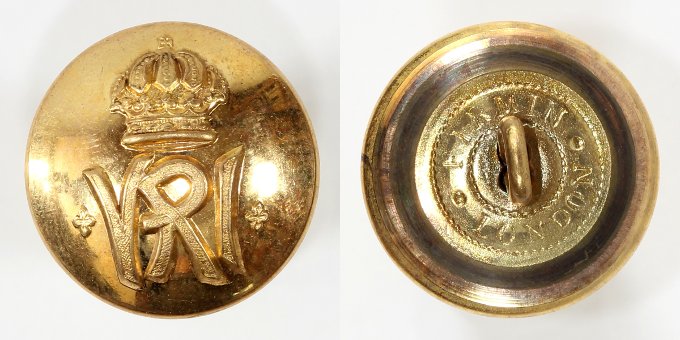
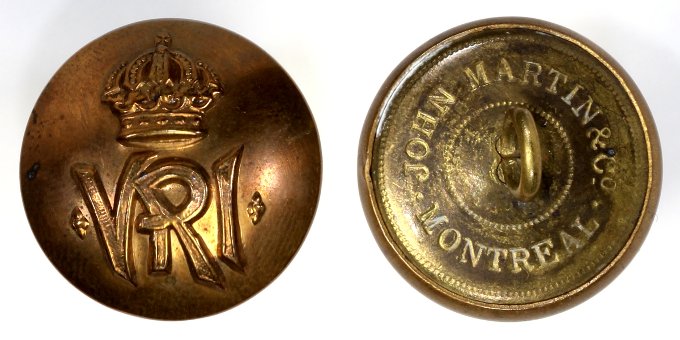
How one Canadian Army regiment celebrates two battle honours that happened on the same dates 650 miles apart.
A regiment's list of battle honours is often colloquially described as "the major battles our regiment fought in." Often the speaker hasn't examine the list closely, other than as a simple list of place names and so they pass on what they have heard without deepening their understanding through personal study. With the evolution of Canadian Army regiments over past decades, it is possible for a regiment's list of honours to present apparent conflicts when two honours overlap in time, but were widely separated geographically. A careful study of a regiment's past, especially of the diverse regimental origins that lad to subsequent amalgamations to form the modern regiment is needed to unravel the conflict. In such cases, the battle honours were won by two separate regiments which, later joined to form the current regiment with its combined list of battle honours. One such example is found with the Royal New Brunswick Regiment.
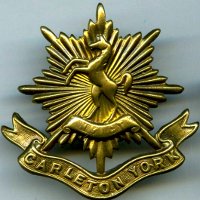 The Carleton and York Regiment
The Carleton and York RegimentThemselves a result of the 1937 amalgamation of the York Regiment and the Carleton Light Infantry, The Carleton and York Regiment was mobilized for the Second World War in 1939. After landing at Pachino, Sicily, on 10 July 1943, as a battalion of the 3rd Canadian Infantry Brigade (1st Canadian Infantry Division), the regiment fought throughout the Sicily and Italy campaigns.
Among the Battle Honours awarded to the Carleton and York Regiment for actions in Italy was the honour "GOTHIC LINE." The defining dates for eligibility for this battle honour are 25 August to 22 September 1944.
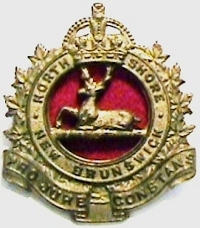 The North Shore Regiment
The North Shore RegimentIn 1922, the Northumberland (New Brunswick) Regiment was redesignated as the North Shore (N.B.) Regiment. The regiment was mobilized in 1940 and, after training in England, landed at Normandy on 6 June, 1944, as a battalion of the 8th Infantry Brigade (3rd Canadian Infantry Division).
Among the Battle Honours awarded to the North Shore (N.B.) Regiment for actions in Northwest Europe was the honour "THE SEINE, 1944." The defining dates for eligibility for this battle honour are 25 to 28 Aug 44.
In 1954, these two proud Canadian regiments were amalgamated again, with one another and also with the New Brunswick Scottish and the 28th Field Battery, Royal Canadian Artillery. This resulted in the two battalions of The New Brunswick Regiment being formed; the 1st Battalion, NBR (Carleton and York) with HQ at Saint John, and the 2nd Battalion, NBR (North Shore) with HQ at Newcastle (later Bathurst), NB. In 1956, the regiment would be granted the Royal honorific, becoming The Royal New Brunswick Regiment (RNBR).
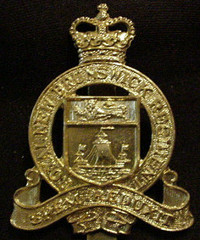 With the pace of administration of Battle Honours lagging behind the speed of reorganization of the Militia, the RNBR would be granted the following Battle Honours in 1957, combining those earned by both the Carleton and York Regiment and the North Shore (N.B.) Regiment:
With the pace of administration of Battle Honours lagging behind the speed of reorganization of the Militia, the RNBR would be granted the following Battle Honours in 1957, combining those earned by both the Carleton and York Regiment and the North Shore (N.B.) Regiment:
1st Battalion, The Royal New Brunswick Regiment (Carleton and York) and 2nd Battalion, The Royal New Brunswick Regiment (North Shore) - "LANDING IN SICILY, Valguarnera, SICILY 1943, Landing at Reggio, Gambatesa, The Sangro, The Gully, Point 59, CASSINO II, Gustav Line, LIRI VALLEY, Hitler Line, Melfa Crossing, GOTHIC LINE, LAMONE CROSSING, RIMINI LINE, San Fortunato, Naviglio Canal, ITALY 1943-45, NORMANDY LANDING, CAEN, Carpiquet, BOURGUEBUS RIDGE, Faubourg de Vaucelles, FALAISE, Falaise Road, Quesnay Wood, The Laison, Chambois, The Seine, 1944, Moerkerke, THE SCHELDT, Breskens Pocket, The Lower Maas, Kapelsche Veer, THE RHINELAND, Waal Flats, The Hochwald, THE RHINE, Emmerich - Hoch Elten, Zutphen, Apeldoorn, Kusten Canal, Bad Zwischenahn, NORTH-WEST EUROPE 1944-45" (Cdn Army Orders, Issue No. 573, 9 December 1957)
It is through this series of amalgamations and changes of name that one regiment can today celebrate two battlefield actions which took place on the same day, though over 600 miles apart.
In 2011, Canadian Defence Minister Peter MacKay announced that the name of the 2nd Battalion, The Royal New Brunswick Regiment (North Shore) will be changed back to the North Shore Regiment. It is yet to be confirmed if this constitutes a reversal of the 1956 amalgamation of regiments that formed the two battalions of The Royal New Brunswick Regiment, which the renaming would appear to indicate. If this reversal is confirmed then the two remaining units, "The Royal New Brunswick Regiment" and the "North Shore Regiment," should revert back to their pre-amalgamation lists of battle honours.
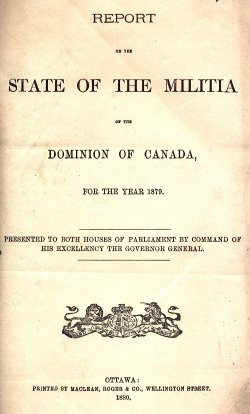 The state of Canadian Militia units in Military District No.1 (headquartered at London, Ontario) was reported to the Adjutant-General of Militia by Lieutenant Colonel John B. Taylor, Deputy Adjutant General of the District and published in the annual Report on the State of the Militia of the Dominion of Canada for the Year 1879. The Establishment of Military District No. 1 was described as follows:–
The state of Canadian Militia units in Military District No.1 (headquartered at London, Ontario) was reported to the Adjutant-General of Militia by Lieutenant Colonel John B. Taylor, Deputy Adjutant General of the District and published in the annual Report on the State of the Militia of the Dominion of Canada for the Year 1879. The Establishment of Military District No. 1 was described as follows:–
Establishment
The total strength of the active militia force in this district, according to the full establishment, is the same as last year, viz.:– 365 officers and 5010 non-commissioned officers and men, and which is comprised in the following corps, viz.:–
Cavalry
Artillery
Infantry
Annual Drill
By General Orders of 29th May, 1879, the maximum strength of the force in this district that was authorized to perform annual drill for 1879-1880, was 2350 of all ranks; and the following corps selected in accordance with with the above orders, performed their 12 days' annual drill of a total strength of 2341, the detail of which are given in the tabular inspection report.
The Cavalry, three batteries of field artillery, and eight battalions and one independent Company of infantry are identified as having participated in the annual drill requirements. Select reports follow.
7th Battalion, "London Light Infantry"
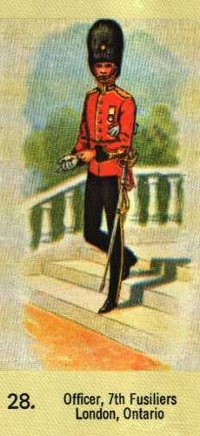 This fine corps performed its annual drill in the evenings, and all ranks paid so much attention amd made so great improvement that I arranged for their attendance at the review in Toronto on the 9th September, in honour of their Excellencies the Governor-General and Princess Louise, with confidence that they would maintain the credit of this military district, and I am proud to say that, though only lately re-organized and a young corps in material, their steadiness under arms, and when marching past at the review, were remarkable, and the quiet and soldierlike manner in which they behaved during the journey to Toronto and back (which is a sure test of the discipline and character of a corps) was highly creditable to both officers and men. The city of London can justly feel proud of its battalion, for altogether I believe it would be difficult to find a smarter and finer battalion of young men than the "London Light Infantry."
This fine corps performed its annual drill in the evenings, and all ranks paid so much attention amd made so great improvement that I arranged for their attendance at the review in Toronto on the 9th September, in honour of their Excellencies the Governor-General and Princess Louise, with confidence that they would maintain the credit of this military district, and I am proud to say that, though only lately re-organized and a young corps in material, their steadiness under arms, and when marching past at the review, were remarkable, and the quiet and soldierlike manner in which they behaved during the journey to Toronto and back (which is a sure test of the discipline and character of a corps) was highly creditable to both officers and men. The city of London can justly feel proud of its battalion, for altogether I believe it would be difficult to find a smarter and finer battalion of young men than the "London Light Infantry."
The battalion turned out in full strength as a guard of honour at the visit of their Excellencies the Governor-General and Princess Louise, and Captain Talbot MacBeth's company, which is very well drilled, and looked remarkably well, mounted guard during the stay of their Excellencies in London.
The 7th Battalion attended 12 days of Annual Drill conducted on summer evenings to meet the training requirement. At the unit's annual inspection, 14 officers and 294 NCOs and men were present out of an establishment of 29 officers and 385 NCOs and men. The unit was described as "Clean and efficient" with "very steady Battalion drill." It was also noted that the unit had a "very good band." The 7th Battalion was issued 5880 ball and 5880 blank rounds for training during this year.
22nd Battalion, "Oxford Rifles"
This battalion performed their annual drill at the local company headquarters, and with one exception I found the companies on my inspection to be well drilled and efficient, with uniform in good order and arms and accoutrements clean. I especially noticed the "Ingersoll" company which, under the energetic care of its Commanding Officer, Brevet-Major Ellis, turned out in a very soldierlike manner, and concluded a long drill in extended order with manual and bayonet exercises, gone through with so much steadiness that it was evident every man in the company had made the most use of his time in camp.
I should mention that much of the steadiness on these companies in drill is due to the teaching of Drill Instructor J. Chinner.
The 22nd Battalion attended 12 days of Annual Drill conducted at local headquarters to meet the training requirement. At the unit's annual inspection, 15 officers and 330 NCOs and men in eight companies were present out of an establishment of 32 officers and 440 NCOs and men. The unit was described as "Clean and efficient" with "Company drill, extended order, manual and firing exercise and bayonet drill; very satisfactory." It was also noted that the unit had a "good band." Each of the eight companies of the 22nd Battalion were issued 840 ball and 840 blank rounds for training during this year.
In 1954, the 7th Battalion, "London Light Infantry" (then known as the Canadian Fusiliers (City of London Regiment)) and the 22nd Battalion, "Oxford Rifles" (The Oxford Rifles) would be amalgamated with The Royal Canadian Regiment, forming the Regiment's Reserve battalion.
 This email text has been floating around the Internet for a few years. It offers an excellent, though possibly apocryphal, description of what can happen when an unprepared and unacclimatized digestive system meets army field rations. Thanks to Ranger Rodgers, wherever he may be.
This email text has been floating around the Internet for a few years. It offers an excellent, though possibly apocryphal, description of what can happen when an unprepared and unacclimatized digestive system meets army field rations. Thanks to Ranger Rodgers, wherever he may be. Subject: Fw: Rations and MREs
Chez Ranger by Frank Rodgers
I had a date the other night at my place. On the phone the day before, the girl asked me to "Cook her something she's never had before" for dinner. After many minutes of scratching my head over what to make, I finally settled on something she has DEFINITELY never eaten. I got out my trusty case of MRE's. Meal, Ready-to-Eat. Field rations that when eaten in their entirety contain 3000+ calories. Here's what I made:
I took three of the Ham Slices out of their plastic packets, took out three of the Pork Chops, three packets of Chicken-a -la-King, and eight packets of dehydrated butter noodles and some dehydrated/dehydrated rice. I cooked the Ham Slices and Pork Chops in one pan, sautéed in shaved garlic and olive oil. In another pot, I blended the Chicken a-la-king, noodles, and rice together to make a sort of mush that looked suspiciously like succotash. I added some spices, and blended everything together in a glass pan that I then cooked in the oven for about 35 minutes at 450 degrees. When I took it out, it looked like, well, ham slices, pork chops, and a bed of yellow poop. I covered the tops of the meat in the MRE cheese (kinda like Velveeta) and added some green sprinkly thingies from one of my spice cans (hey, if it's got green sprinkly thingies on it, it looks fancy right?) For dessert, I took four MRE Pound Cakes, mashed 'em up, added five packets of cocoa powder, powdered coffee cream, and some water. I heated it up and stirred it until it looked like a sort of chunky gelatinous organism, and I sprinkled powdered sugar on top of it. Voila--Ranger Pudding. For alcoholic drinks, I took the rest of my bottle of Military Special Vodka(yes, they DO make a type of liquor named "Military Special"--it sells for $4.35 per fifth) and mixed in four packets of "Electrolytes - 1 each - Cherry flavored" (I swear, the packet says that). It looked like an eerie kool-aid with sparkles in it (that was the electrolytes I guess... could've been leftover sand from Egypt). I lit two candles, put a vase of wildflowers in the middle, and set the table with my best set of Ralph Lauren Academy-series China (that shit is EXPENSIVE... my set of 8 place settings cost me over $600), and put the alcoholic drink in a crystal wine decanter.
She came over, and I had some appetizers already made, of MRE spaghetti-with-meatballs, set in small cups. She saw the dinner, saw the food, and said "This looks INCREDIBLE!!!"
We dug in, and she was loving the food. Throughout the meal, she kept asking me how long it took me to make it, and kept remarking that I obviously knew a thing or two about cooking fine meals. She kind of balked at the makeshift "wine" I had set out, but after she tried it I guess she liked it because she drank four glasses during dinner.
At the end of the main course, when I served the dessert, she squealed with delight at the "Chocolate mousse" I had made. Huh? Chocolate what? Okay... yeah... it's Chocolate Moose. Took me HOURS to make... yup.
Later on, as we were watching a movie, she excused herself to use my restroom. While she was in there, I heard her say softly to herself "uh oh" and a resounding but petite fart punctuated her utterance of dismay.
Let the games begin.
She sprayed about half a can of air freshener (Air Freshener, 1 each, Orange scent. Yup. The Army even makes smell good) and returned to the couch, this time with an obvious pained look.
After 10 more minutes she excused herself again, and retreated to the bathroom for the second time. I could hear her say "What the hell is WRONG with me???," as she again send flatulent shockwaves into the porcelain bowl. This time, they sounded kinda wet, and I heard the toilet paper roll being employed, and again, LOTS more air freshener.
Back to the couch. She smiles meekly as she decides to sit on the chair instead of next to me. She sits on my chair, knees pulled up to her chest, kind of rocking back and forth slightly. Suddenly, without a word, she ROCKETED up and FLEW to the bathroom, slammed the door, and didn't come out for 30 minutes.
I turned the movie up because I didn't want her to hear me laughing so hard that tears were streaming down my cheeks.
She came out with a slightly gray pallor to her face, and said "I am SOOOOOO sorry. I have NO idea what is wrong with me. I am so embarrassed, I can't believe I keep running to your bathroom!!" I gave her an Imodium AD, and she finally settled down and relaxed.
Later on, she asked me again what I had made for dinner, because she had enjoyed it so much. I calmly took her into the kitchen and showed her all the used MRE bags and packets in the trash can.
After explaining to her that she had eaten roughly 9,000 calories of "Army food" she turned stark white, looked at me incredulously, and said "I ate 9,000 calories of dehydrated food that was made 3 years ago?" After I concurred, she grabbed her coat and keys, and took off without a word.
She called me yesterday. Seems she couldn't shit for 3 days, and when she finally did, the smell was so bad, her roommate could smell it from down the hall. She also told me she had been working out nonstop to combat the high caloric intake, and that she never wanted me to cook dinner for her again, unless she was PERSONALLY there to inspect the food beforehand.
It was a fun date. She laughed about it eventually, and said that that was the first time she'd ever crapped in a guy's house on a date. She'd been so upset by it she was in tears in the bathroom while I had been in tears on the couch.
I know, I'm an asshole, but it was still a funny night. I almost wet myself laughing.
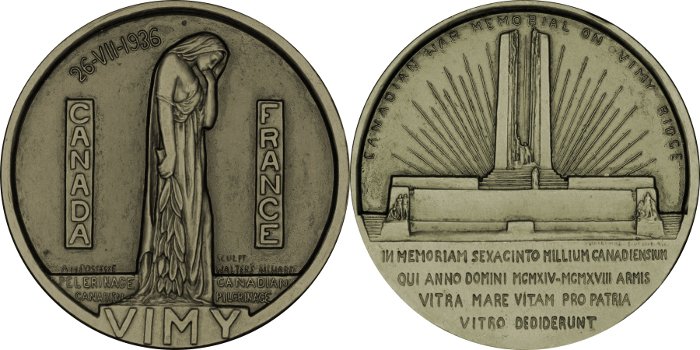
In July 1936, the Vimy Pilgrimage saw 6000 Canadians, both veterans and family members of survivors and casualties, sail to Europe on five liners of the Canadian Pacific and Cunard lines to attend the unveiling of the Vimy Memorial. Joined by many other Canadians who were already overseas, over 800 were in attendance when King Edward VIII unveiled that great monument on 26 July, 1936.
The schedule for the Pilgrimage saw the many voyagers travel to England for a few days after then unveiling after which, by special invitation of France, 5000 Pilgrims again crossed the Channel to visit and tour. One highlight of this tour was a grand banquet for the 5000 Pilgrims at the Hôtel des Invalides on 2nd August, 1936. During this banquet, each pilgrim was presented with a gift from the grateful nation of France. The Vimy Pilgrimage book which recounts the trip, "The Epic of Vimy," makes only passing mention of this offering, the Vimy medallions:
"Throughout its duration commemorative medals minted by the Republic of France as a souvenir of the Vimy Unveiling and of the visit of the Pilgrims were distributed to each one. These are in bronze and are appropriately impressed with the heroic figures of the Canadian memorial on Vimy Ridge."
Marshall Phillippe Pétain spoke to the Pilgrims on this occasion, his remarks are recorded in the "Epic of Vimy" and begin as follows:
"Soldiers need no lengthy speeches in order to understand each other. Let me express to you simply and in a few words the profound and sincere pleasure it gives to the war veterans of France to welcome the members of the Canadian Legion."
"During the war the daily communiqués from the front reported reverses: for the Canadians they announced only victories. They were doughy fighters who gained the objectives assigned to them, nor did they allow these to be retaken. The memory of the Canadians remains vibrant within the heart of the French poilu, for he who has endured the severest tests knows how to appreciate real valour. St. Eloi, Langemarck, Festubert, Passchendaele, Vimy — all those places where you covered yourselves with renown are as familiar to us as the Battle of Tahure, Verdun or Hartsmanweilerkopf."
"This rampart of Vimy which you stormed on April 9th, 1917, dominates the Plain of Douai. That you have seen for yourselves. From 1914 the French High Command recognized its importance. Upon its occupation depended the possibility of effective action against the only vulnerable flank of the enemy. Thus on May 9th, 1915, the 33rd French Army Corps, which I had the honour to command, received the order to capture it."
"The Moroccan Division, detailed to the assault, crossed the Ridge and penetrated into Petit Vimy, but in the face of furious counter-attacks were obliged to withdraw. It then required two more years before we became masters of those heights. That was your work."
"Your four Divisions, supported by the powerful artillery, launched themselves forward in the dawn of April 9th, 1917, and overcoming all German resistance, captured numerous prisoners and much war material. The Canadian Corps, happier than the 33rd French Corps in May, 1915, assured after a violent contest the definite possession of this position which was of utmost strategic value."
The bronze Vimy medallions are 50 millimetres in diameter and 4 millimetres thick. The face of the medallion features a bas-relief of the Vimy Memorial statue of Canada mourning, with the following texts, either raised or inscribed:
On the reverse is a silhouette of the monument, with the following texts:
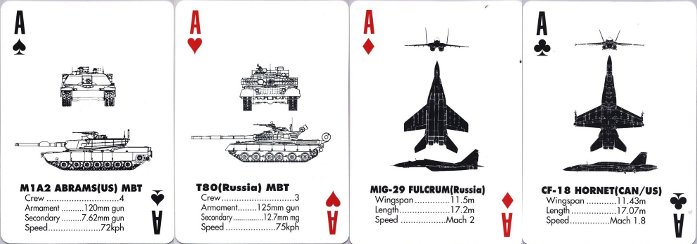 Playing cards marked with silhouettes to practice recognition of armoured fighting vehicles and aircraft were a novelty given or sold to soldiers during the Cold War. A late edition of such cards was produced by Woods Manufacturing, of Ottawa, Ontario, (now Guthrie Woods.
Playing cards marked with silhouettes to practice recognition of armoured fighting vehicles and aircraft were a novelty given or sold to soldiers during the Cold War. A late edition of such cards was produced by Woods Manufacturing, of Ottawa, Ontario, (now Guthrie Woods.
The four aces for this deck, pictured above, featured the following:

The most common medal awarded to Canadians for service in the First World War is the British War Medal. This medal could be issued as the recipient’s sole entitlement, or it could be accompanied by the Victory Medal for those who served in a theatre of war, and, for those whose service in theatre started before the end of 1915, the 1914-15 Star. These groupings are colloquially referred to as the First World War "pair" (BWM + VM) and the "trio" (1914-15 Star + BWM + VM). Of these three medals, only the British War medal could be issued as a sole entitlement, i.e., without accompanying medals.
The British War Medal was awarded to any serviceman or woman who served outside Canada’s 3-mile limit, thus making those whose wartime service at sea (with a minimum of 28 days of mobilized service required) or on garrison duty in Bermuda eligible for this medal. As with any award, there were "special cases," for example, those who enlisted in the Overseas Military Forces of Canada in the UK were required to then serve outside of the UK to be eligible for the British War Medal.
Authorized for issue on 26 July 1919, most Canadians would have received their BWMs by the early 1920s. It is not unusual to see photographs from that era of soldiers wearing the ribbons for medals they had not yet received, holding place in their incomplete medal groups. Almost 430,000 British War medals were issued to Canadians who served outside of Canada during the Great War.
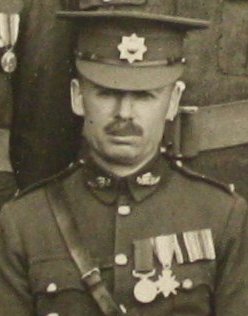
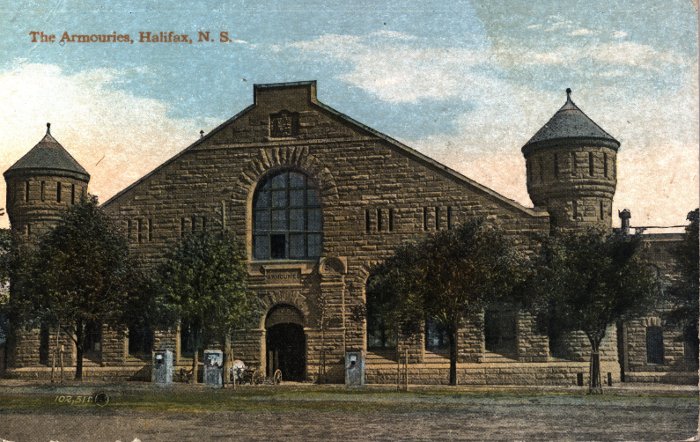
The above view of the Halifax Armouries is its most recognizable face to many people today. Haligonians whose daily commute or leisure activities take them along the main arteries bounding the Halifax Commons southwest of the Armouries would have no problem identifying the building by this profile. It is not, however, the "front" of the building as intended by the original design. As often happens when a city's evolution diverges from the orientations of its older architecture, the face of the Halifax Armouries actually fronts on Cunard Street, and not North Park Street (which runs across the side of the building as shown above).
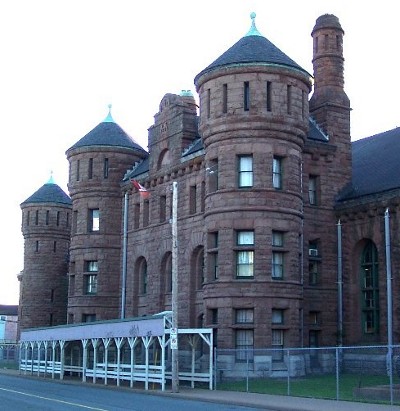 The Halifax Armouries was constructed between 1895 and 1898 at a final cost of $250,000 (over budget by $75,000), designed by Thomas Fuller, Chief Dominion Architect for the Department of Public Works, it's original purpose was to provide new accommodation for the city's Militia regiments, a duty to it continues to serve to this day.
The Halifax Armouries was constructed between 1895 and 1898 at a final cost of $250,000 (over budget by $75,000), designed by Thomas Fuller, Chief Dominion Architect for the Department of Public Works, it's original purpose was to provide new accommodation for the city's Militia regiments, a duty to it continues to serve to this day.
Constructed by J.E. Askwith Co. of Ottawa, the Armories' outer walls required $17,000 worth of freestone which was quarried in Pugwash. The the interior was lined with $35,000 of pressed brick. Construction of the foundation required 16,000 cubic feet of granite, and the whole was held together by 35,000 barrels of cement mortar.
At 50 metres wide by 92 metres long, the building provided one of the largest enclosed and unpillared spaces in the Dominion at the time of its construction, rivaled only by another Armoury in Toronto which was also designed by Fuller and used new iron and steel roof trusses to provide for a wide open drill floor. The Halifax Armouries was also he first building of its type to have electric lighting included from the design stage.
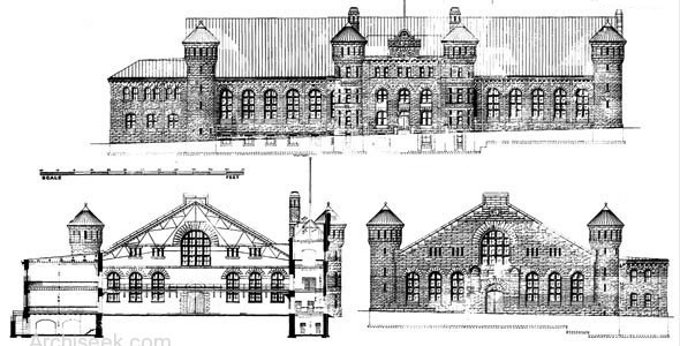
The Halifax Armouries remains the home of these Reserve units:
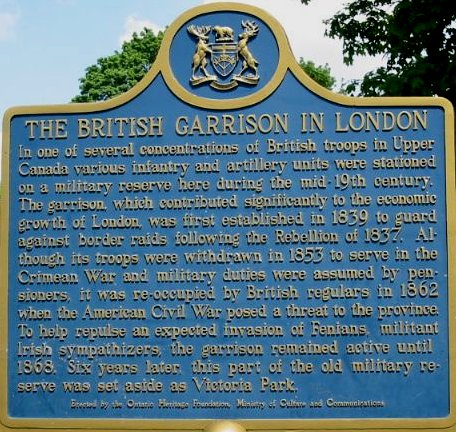 In the days of British garrisons in Upper and Lower Canada, the method used to transfer skills to the officers of the Canadian Militia was the temporary establishment of "Schools of Instruction" by garrison battalions. Transitory in nature, in contrast to the established Royal Schools of the Canadian Infantry School Corps after 1883, these Schools of Instruction were individually authorized, conducted by the Commanding Officer of the designated British battalions, and qualified officers for command at company or battalion level. After the withdrawal of most of the British garrison units in the late 1860s, the Militia Department attempted to conduct a similar school system using qualified Militia officers to conduct the training. This approach was found wanting, most likely due to problems of consistency of training and availability of resources, and by the early 1880s led to the recognition of a need for established schools for infantry. The result was the creation of the Canadian Infantry School Corps, which is today The Royal Canadian Regiment.
In the days of British garrisons in Upper and Lower Canada, the method used to transfer skills to the officers of the Canadian Militia was the temporary establishment of "Schools of Instruction" by garrison battalions. Transitory in nature, in contrast to the established Royal Schools of the Canadian Infantry School Corps after 1883, these Schools of Instruction were individually authorized, conducted by the Commanding Officer of the designated British battalions, and qualified officers for command at company or battalion level. After the withdrawal of most of the British garrison units in the late 1860s, the Militia Department attempted to conduct a similar school system using qualified Militia officers to conduct the training. This approach was found wanting, most likely due to problems of consistency of training and availability of resources, and by the early 1880s led to the recognition of a need for established schools for infantry. The result was the creation of the Canadian Infantry School Corps, which is today The Royal Canadian Regiment.
The following text is the authorizing General Order for a School of Instruction conducted at the London garrison in 1865.
Headquarters
Quebec, 27th April, 1865
Service Militia; Upper Canada
His Excellency the Commander-in-Chief has made arrangements with His Excellency the Lieutenant General Commanding Her Majesty's Forces in British North America, for the establishment of a School of Military Instruction at London, in connection with the 1st Battalion of the 16th Regiment of Her Majesty's Forces.
This school will be opened for the reception of candidates on Tuesday, the 16th of May proximo, and His Excellency is pleased to order the following Rules and Regulations for the guidance of all concerned, viz:
1. All Candidates for Commissions in the "Service" Militia, will be required before appointment, to obtain a certificate, as hereinafter mentioned, from the Commandant of one of the Schools of Military Instruction; and no person shall be appointed or promoted to the rank of Field Officer in the "Service" Militia who shall not have obtained a "First class" certificate.
2. A "First class" certificate shall be given to those candidates who shall have proved themselves, to the satisfaction of he Commandant of the School of Military Instruction, able to drill and handle a Battalion in the field, and who shall have acquired a competent acquaintance with the internal economy of a Battalion.
3. A "Second class" certificate shall be given to those candidates who shall have proved themselves able to command a Company at Battalion drill, and to drill a Company at "Company Drill," and who shall have acquired a competent acquaintance with the internal economy of a Company and the duties of a Company's officers.
4. All candidates for admission to the Schools of Military Instruction will be required, before admission, to satisfy a Board of officers of their competence for the position of commissioned officer of the Militia.
5. No candidate shall be permitted to remain at the Schools of Military Instruction after he shall have obtained a second class certificate, without the special permission of the Commander in Chief.
6. No certificate of either class shall be given to any candidate who is not himself perfectly drilled as a private soldier.
7. No candidate shall be permitted to remain at any of the schools for a longer period than three calendar months from the date of his entry.
8. The traveling expenses of all candidates in coming to, and returning to their homes from the school shall be paid.
9. All candidates on obtaining a "Second class" certificate, shall be paid a sum of Fifty dollars, and on obtaining a "First class" certificate , the further sum of Fifty dollars in addition.
10. All Candidates for Commissions, while attending the school, shall be considered for all purposes of drill and discipline to be attached to the Regiment which shall constitute the School of Instruction; and it shall be competent to the Commander in Chief, on a representation from the Commandant, to dismiss any candidate from the school, for misconduct or for other sufficient cause.
11. Candidates for Commissions, while attending the school, shall not be Members of the Mess of the Regiment which constitutes the school.
The following officers are appointed as a Board of Examiners of candidates for admission to the School of Military Instruction at London:--
By Command of His Excellency the Right Honorable the Governor-General and Commander-in-Chief.
WALKER POWELL, Lt.-Colonel, Deputy Adjutant General of Militia, Upper Canada.
The following equipment carried by the dismounted soldiers is detailed in the Field Service Pocket Book; Edition 1914 (Amendments 1916).
This table applies primarily to infantry. Certain exceptions (prescribed in the Equipment Regulations) are necessary in the case of dismounted men of other arms. Range takers of infantry carrying the one-man instrument will be armed with pistols, and will carry neither rifles, bayonets, nor intrenching implements.
| Detail | No. | Approximate weight. | Remarks | |
lbs | ozs | |||
| A. — Clothing, &c., worn by the Soldier. | ||||
Boots, ankle, pair * | 1 | 4 | 4 | * For kilted regiments substitute:—
|
Braces * | 1 | 0 | 4 ½ | |
Cap, service dress (or glengarry), with badge | 1 | 0 | 9 | |
Disc, identity, with cord | 1 | 0 | ¼ | |
Drawers, woolen, pair * | 1 | 1 | ½ | |
Jacket, service dress *, and metal titles, with field dressing | 1 | 2 | 8 | |
Knife, clasp, with marlin spike and tin opener | 1 | 0 | 8 | Troops wearing khaki drill sent on active service from a arm to a temperate climate will be supplied with service dress jackets and trousers as soon as available. In warm weather the cardigan may be carried in the pack. |
Paybook (in right breast pocket of S.D) jacket) | 1 | 0 | 2 | |
Puttees, pair * | 1 | 0 | 13 | |
Shirt | 1 | 1 | 2 | |
Socks, pair | 1 | 0 | 4 ¼ | |
Trousers, service dress * | 1 | 2 | ½ | |
Waistcoat, cardigan | 1 | 1 | 7 | |
| TOTAL (A) | 14 | 11 |
| |
| B. — ARMS | ||||
Rifles, with oil bottle, pull-through, and sling | 1 | 8 | 15 ¾ | Drummers and buglers are unarmed. Men of the M.G. detachments will place their rifles in the limbered wagon when the M.G. is removed. Men leading pack animals will carry their rifles slung. N.C.Os. armed as staff-serjeants have no bayonet. Pipers wear dirks. |
Bayonet and scabbard | 1 | 1 | 8 ¾ | |
| TOTAL (B) | 10 | 8 ½ |
| |
| C. — AMMUNITION | ||||
Cartridges, S.A., ball, .303-inch, rounds | 150 | 9 | 0 | N.C.Os. equipped as staff-serjeants carry 25 rounds. Pioneers carry 80 rounds. Signallers carry 50 rounds. Drummers and buglers have no S.A.A. Pipers carry 12 rounds of pistol ammunition. |
| D. — TOOLS | ||||
Implement, intrenching, pattern 1908, head | 1 | 1 | 5 ¾ | Colour-serjeants, N.C.Os., armed as staff-serjeants, pipers and signaller carry no intrenching implements. (For signallers the implements are carried in tool wagons.)
|
Ditto, helve | 1 | 0 | 8 ¼ | |
Carriers for ditto, head | 1 | 0 | 9 ½ | |
Carriers for ditto, helve | 1 | 0 | 1 ¾ | |
| TOTAL (D) | 2 | 9 ¼ |
| |
| E. — ACCOUTREMENTS | ||||
Waterbottle, with carrier | 1 | 1 | 6 | The armourer has a waist-belt and two 15-round cartridge pockets, bandolier equipment, pattern 1903; and a great-coat strap and mess-tin strap, valise equipment, pattern 1888. |
Web equipment, pattern 1908:— | ||||
Belt, waist | 1 | 0 | 13 | |
Braces, with buckle | 2 | 0 | 11 | |
Carriers, cartridge, 75 rounds, left | 1 | 0 | 14 ½ | |
Ditto, right | 1 | 0 | 14 ½ | |
Frog | 1 | 0 | 3 | |
Haversack (18 ¾ ozs), with knife (3 ozs), fork (3 ozs), and spoon (2 ½ ozs) | 1 | 1 | 11 | |
Pack, with supporting straps (2) | 1 | 1 | 11 | |
| TOTAL (E) | 8 | 4 ¼ |
| |
| F. — ARTICLES CARRIED IN THE PACK | ||||
Cap, comforter | 1 | 0 | 4 | Nos. 1 to 4 of M.G. section will have their packs carried for them on the march, in the G.S. limbered wagon for M.G. |
Holdall (3 ¼ ozs), containing laces (½ oz), toothbrush (½ oz), razor and case (3 ozs), shaving brush ( 1 ¾ oz), and comb (1 oz.) | 1 | 0 | 9 ¼ | |
Greatcoat, with metal titles | 1 | 6 | 10 ½ | |
Housewife, fitted | 1 | 0 | 3 ¼ | |
Mess-tin and cover | 1 | 1 | 6 ½ | |
Socks, worsted, pair | 1 | 0 | 4 ¼ | |
Soap | 1 | 0 | 3 | |
Towel, hand | 1 | 0 | 9 | |
| TOTAL (F) | 10 | 1 ¾ |
| |
| G. — RATIONS AND WATER | ||||
Bread ration (unconsumed portion), say | . | 0 | 12 |
|
Cheese | . | 0 | 3 | |
Iron ration:— | ||||
Biscuit | 0 | 12 | ||
Preserved meat (nominal) | 1 | 0 | ||
Tea (3/8 oz), Sugar (2 oz), Salt (½ oz); in a tin | 0 | 6 ½ | ||
Cheese | 0 | 3 | ||
Meat extract, cubes | 2 | 0 | 1 | |
Water, pints | 2 | 2 | 8 | |
| TOTAL (G) | 5 | 13 ½ |
| |
| TOTAL WEIGHT CARRIED | ||||
A.— Clothing worn | 14 | 11 | This is the normal weight carried by a private. But exceptions occur in the case of N.C.Os. and certain other ranks (signallers, range takes, &c.). | |
B.— Arms | 10 | 8 ½ | ||
C.— Ammunition | 9 | 9 | ||
D.— Tools | 2 | 9 ¼ | ||
E.— Accoutrements | 8 | 4 /4 | ||
F.— Articles in pack | 10 | 1 ¾ | ||
F.— Rations and water | 5 | 13 ½ | ||
| TOTAL | 61 | ¼ |
| |
The above arrangements allow of the soldier having normally with him the whole of his equipment; but in circumstances the commander may decide to increase the amount of S.A.A. carried on the person, and to discard temporarily certain articles of equipment, e.g., pack and contents.
lbs. | ozs. | |
Marching order (as above) | 60 | 11 ¼ |
Deduct pack and contents (F) | 11 | 11 ¾ |
| 48 | 15 ½ |
Add 100 rounds S.A.A., in two 50-round bandoliers | 6 | 2 |
Total "fighting equipment" (without pack, but with 250 rounds S.A.A.) | 55 | 1 ½ |
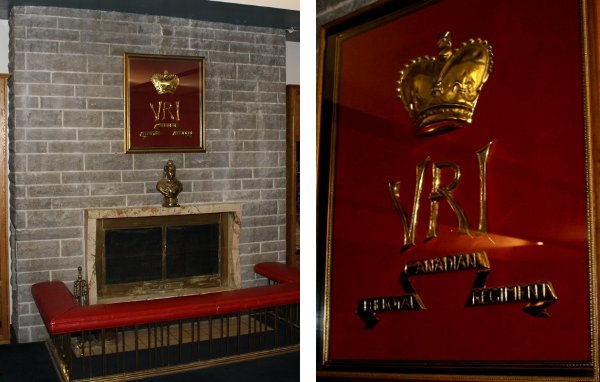
To this day, above the fireplace in Wolseley Barracks Officers' Mess, hangs the cast brass crown, “VRI” and scroll that constitutes the regimental cypher. These were designed and produced by London sculptor (originally of Owen Sound) Mrs Anna Brown, nee Shields. Mrs Brown was a graduate of the Ontario College of Arts.
While many who have visited the Mess have seen the cypher over the fireplace, often they remained unaware that two more examples of the crown and VRI are also to be found within the Mess. Inside the Mess entryway is a second set of double doors. Normally propped open, this positioning hides the fact that on each door, mounted on the black leather upholstery that covers the doors, are to be found two more sets of the cypher castings.
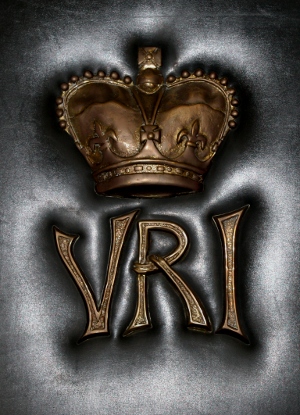
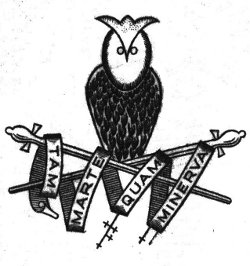
Course journal; publication of the Defence Services Staff College, Wellington, India
| Serial (a) | Term (b) | Meaning (c) |
| 1 | Take remedial action. | Find some means of sorting this mess out. I cannot think of any. |
| 2 | Transferred for appropriate action. | I hope you will know what to do with this. |
| 3 | Emphasize this point. | Expand one page to fifteen. |
| 4 | Read and initial. | Spreading the responsibility for doing nothing on this. |
| 5 | Your recommendations are being examined. | More time is needed to think of an answer though a couple of months have already elapsed. |
| 6 | A modified policy. | A complete reversal which nobody admits. |
| 7 | A coordination staff officer. | An officer who has a desk between two expediters. |
| 8 | Under active consideration. | We are looking in the files for it. |
| 9 | Under consideration. | Never heard of it. |
| 10 | Expedite. | To compund confusion with commotion. |
| 11 | Resubmit through proper channels. | Tactical delaying action in respect of distasteful or troublesome communication. |
| 12 | Put up this letter on its file. | I do not know what action to take on it. I hope you do by the time you put it up. |
| 13 | File it. | I could not care less. I hope you do not either. |
| 14 | We may agree. | I cannot find any reason for objecting to the proposal but I dare not say 'I agree.' |
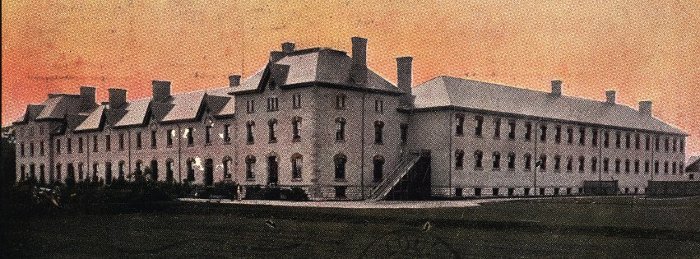
Members of Parliament who are quoted below are:
House of Commons of the Dominion of Canada
Fourth Session – Fifth Parliament
2 June 1886
London Infantry School – $30,000
Mr. Blake – Will the hon. gentleman explain the vote of $30,000 for the London Infantry School?
Sir Hector Langevin – It is to enable the chief architect to carry on the work of the proposed new barracks. The cost of the barrack building, including furnishing, heating, etc., is estimated at $75,000; then there is $3,600 for the architect and $2,000 for the clerk of works, the total estimated cost being $81,000.
Mr. Blake – Has the hon. gentleman received any information as to difficulties with the drainage of the site of the school.
Sir Hector Langevin – I have not.
Mr. Blake – It has been stated in the papers that there are serious difficulties, and that pile driving will have to be resorted to in order to overcome them.
Mr. Carling – The architect was in the city yesterday, and he says that the difficulty can be overcome by the construction of a drain.
Mr. Blake – I suppose this is the property as to which the tripartite agreement was made some time ago, under which the city bought some property from the Minister of Agriculture, and the hon gentleman took that property and gave the city some other property?
Sir Adolphe Caron – Yes
Mr. Blake – Will the hon. gentleman state the nature of the arrangement?
Sir Adolphe Caron – In 1884, on the recommendation of General Middleton, it was determined to establish an Infantry School in London. The citizens of London were very adverse to the school being established on the Government Property, for reasons which they set forth. Upon that recommendation, three sites were offered, the Geary site, the Kent Site, and the Carling farm. The matter was submitted to the brigade major of the district, and he recommended the Carling farm as the most suitable. The offer made to the city was $10,000 in cash and a deed of 16 acres of land of Government property and the right to use some 90 acres adjoining for camping purposes for 20 years, for 8 acres of land now used as our military property. The proposition was approved by Order in Council; but it had to be submitted to a vote of the ratepayers of London, who rejected it. Subsequently, however, the city made a new proposition, that they would give a free deed of fifty-five acres of the Carling farm within city limits, which has been used as a military camp-ground for many years, for eight acres of the Government property referred to in the former proposition. This proposition was again referred to the brigade major, and was referred by him to Mr. George Durand, a well-known architect of London, on the 26th of April, 1885. A valuation of the two properties was sent in by him. The Government property was estimated at $141, 355 and the fifty–five acres of the Carling farm were estimated at $46,000. I was not satisfied to take this valuation; I wanted to get more than one, and the proposition was again submitted to the valuation Mr. McElheran, and auctioneer and valuator, and Mr. William M. Ward, a real estate agent, and these gentlemen reported the value of the Government property at $39,030, and the fifty-five acres of the Carling farm at $44,000. This subsequent offer of exchange was referred to the council and approved, and the exchange has been made, and the contract for the building let, and the work is now going on. I will bring down and lay on the Table all the papers.
Mr. Blake – Is Mr. Durand the architect of the building now?
Sir Hector Langevin – Yes.
Mr. Blake – It has been represented outside, from time to time, that this institution, which is to be erected in or near London, is to be analogous to the Kingston College.
Sir Adolphe Caron. – No; it is to be analogous to the School of Infantry, Toronto.
Although Mr Durand is identified above as the architect for the new Infantry School in London, the building was designed by Henry James, Chief Architect for the Militia Department. (With thanks to Dr Georgiana Stanciu, Curator of The Royal Canadian Regiment Museum, for this confirmation.)
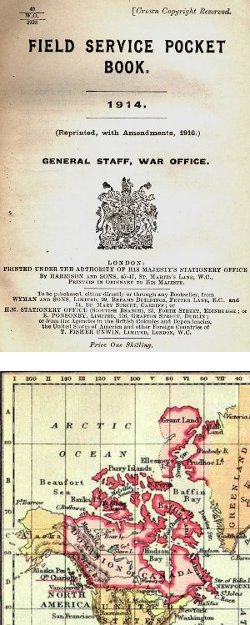 An essential part of the equipment and references carried by every officer of the British Army and Commonwealth forces in the early 1900s was a copy of the Field Service Pocket Book. The standard aide memoire of officers on operations anywhere in the Empire, this little volume provided all manner of information necessary for planning and conducting operations, ranging through staff duties, rates of march, engineering and logistic guidance, and details on the forces of the Empire.
An essential part of the equipment and references carried by every officer of the British Army and Commonwealth forces in the early 1900s was a copy of the Field Service Pocket Book. The standard aide memoire of officers on operations anywhere in the Empire, this little volume provided all manner of information necessary for planning and conducting operations, ranging through staff duties, rates of march, engineering and logistic guidance, and details on the forces of the Empire.
The 1914 edition of the Field Service Pocket Book provides the following description of the forces of the Dominion of Canada:
CANADA
| Nature of Force | Time of Engagement (Years) | Arms and Armament (exclusive of that of Fixed Defences) |
| Permanent Militia | 3 | 4.7" Q.F., 18-pr Q.F., 13-pr Q.F., 12-br B.L., 60-prs and howitzers, M.L.E. and Ross rifles, and Maxims |
| Active Militia | 3 | As above. |
| Royal N.W. Mounted Police | 5 | M.L.M. and Winchester carbines, Colt revolvers, Maxims and Maxim-Nordenfeldts |
Units of all arms and departments. The permanent force and active militia together comprise:–
Organized as 7 mounted brigades, 10 brigades field artillery, and 23 infantry brigades and army troops.
A Militia Council, presided over by the Minister of Militia and Defence, administers the forces.
Eastern Canada is sub-divided into six divisional areas, in each of which a division of all arms is organized, together with 4 cavalry brigades.
Western Canada is divided into three military districts.
Organized into 12 divisions and administered by a Controller at Ottawa.
All males between 18 and 60 are liable for service in time of emergency.
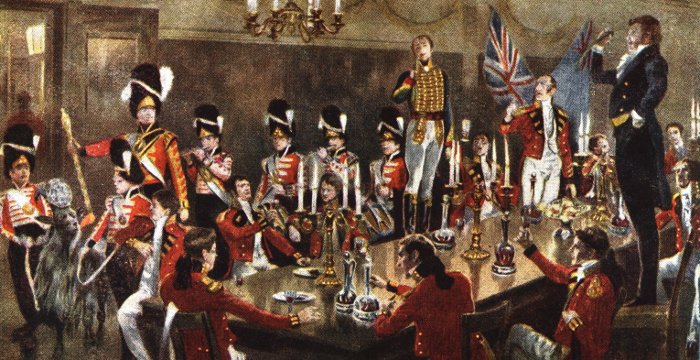
It will be a sad day and an evil day for the British Infantry if the reformers succeed in weakening or destroying the regimental tradition. - Field-Marshal Earl Wavell, 1950
This 1989 BBC series explores the world of British military tradition.
First transmitted in 1989, this is the first episode in a six-part series which delves into the world of regimental tradition. This programme includes looks at the origins of Emperor Joseph Bonaparte's chamber pot, a druid oration and the story of goat who escaped being eaten to become a regimental mascot.
First transmitted in 1989, this is the second in a six-part series which delves into the world of regimental tradition. This film includes the story of Millie the Mule and just why a rose is still eaten, raw, in one battalion's mess. It also features the 'White Helmets' a team of motor cycle stunt riders. One team of retired soldiers has an average age of 74 years but they still meet up to perform stunts in front of their successors.
First transmitted in 1989, this third film in a six-part series delving into the world of regimental tradition looks Gurkhas' history and commitment to the British Army. They swear their oath of allegiance directly to Her Majesty the Queen and continue to revere 'The Queen's Truncheon', which was awarded to them by Queen Victoria in recognition of their service during the Indian Mutiny.
First transmitted in 1989, this is the fourth in a six-part series which delves into the world of regimental tradition. It looks at the illustrious history of the Royal Scots Greys with an account of how a French Imperial Eagle was won at Waterloo, and covers the tragic events of the Charge of the Light Brigade, the origins of the Victoria Cross and follows the transition from horse to the tank.
First transmitted in 1989, this is the fifth in a six-part series which delves into the world of regimental tradition. It features stories about the Grenadier Guards, the favourite tipple of the Queen's Lancashire Regiment and how the King's Own Scottish Borderers made porridge palatable.
First transmitted in 1989, this is the final part of a six part series which delves into the world of the British Army's Regimental traditions and the stories behind them. This is a world where a Napoleonic Drum Major's staff remains prized booty, a dog wears campaign medals awarded by Queen Victoria's command and snuff is served from a ram called George.
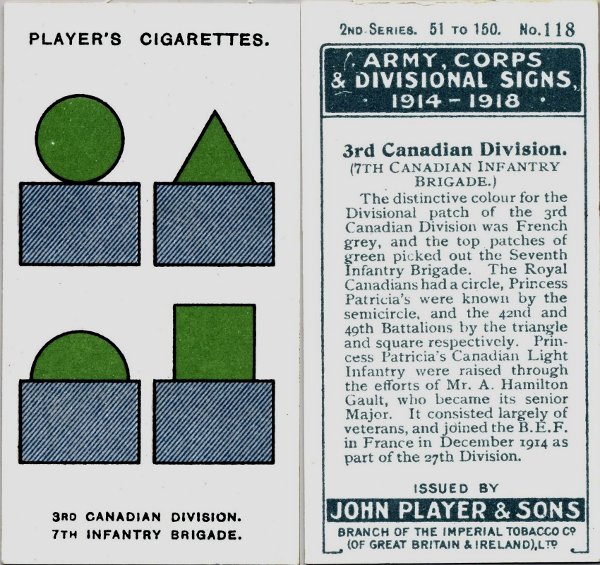
The 7th Canadian Infantry Brigade was formed in France on the 22nd December, 1915. The units comprising the Brigade being:-
Lieut. Colonel A.C. Macdonell, D.S.O. Officer Commanding Lord Strathcona's Horse (Royal Canadians) was appointed Brigade Commander with the temporary rank of Brigadier General, and took over the Command of the 7th Brigade on the 22nd December, 1915. General Macdonell has seen considerable fighting, being present at the actions at Festubert, Givenchy, and Cuinchy besides which he had previously seen active service in the South African War, in Command of Canadian Mounted Rifles.
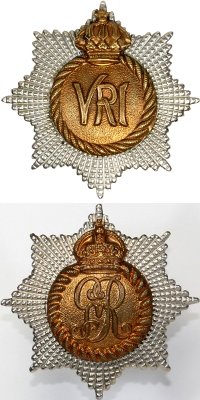 THE ROYAL CANADIAN REGIMENT
THE ROYAL CANADIAN REGIMENT
The Royal Canadian Regiment was raised as a unit of the Canadian Permanent Force in December 1883 under the name of the Infantry School Corps, being raised primarily for the purpose of instructing the Canadian Militia, but its establishment being increased it took over the garrisoning of places occupied by Imperial Troops. A detachment took part in the Expedition in North West Canada, 1884-1885, and bears that honour, and Saskatchewan, in 1899 2nd Battalion was raised for service in the South African War 1899-1900 and was present at the battle of Paardeberg. A 3rd Battalion was raised to garrison Halifax, Canada. Both these Battalions were disbanded after the South African War.
The Regiment bears the Badge of the Imperial Cypher V.R.I. and Imperial Crown granted by Her Majesty Queen Victoria in 1894. On the outbreak of the European war the Regiment was mobilized at Halifax, Nova Scotia and occupied the defences at that station, with detachments at defensive points throughout Nova Scotia.
Having been brought up to War strength by recruits from the Canadian Expeditionary Force Camp at Valcatier P.Q. the Regiment sailed for Bermuda on September 10th 1914 And relieved the 2nd Battalion Lincolnshire Regiment. On being relieved by the 38th Battalion Canadian Overseas Expeditionary Force it proceeded to England via Halifax leaving Bermuda on August 13th 1915, arriving in England September 5th 1915. It was rearmed and equipped at Shorncliffe, casualties being filled by drafts from Canada and volunteers from the other Canadian Battalions at Shorncliffe. The Regiment landed in France on November 1st and proceeded to Bailleul, being billeted around Meteren and forming part of Corps troops of the Canadian Corps. A week later it moved to Westhof and went into the trenches for instruction in trench warfare with the 2nd Canadian Infantry Brigade at Ploegstreert [Ploegsteert] The Regiment then moved to LaClytte – 2nd Canadian Divisional Area – on November 19th where after supplying working parties for front line trenches and supports for about a month it moved to Boeschepe and became part of the 7th Canadian Infantry Brigade on the 22nd December 1915.
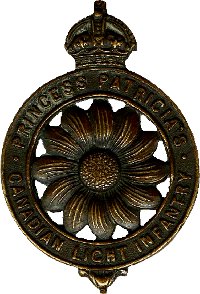 PRINCESS PATRICIA'S CANADIAN LIGHT INFANTRY.
PRINCESS PATRICIA'S CANADIAN LIGHT INFANTRY. Among the many Regiments serving in France and elsewhere on the side of the Allies few have been inaugurated under more favourable auspices than The Princess Patricia's Canadian Light Infantry. Owing to the untiring energy and generosity of Major A. Hamilton Gault, D.S.O., authority was granted, one week after the war was declared, to raise one Battalion to form part of the Canadian Expeditionary Force. To facilitate recruiting depots were established at Montreal, Toronto, Winnipeg, Manitoba, Calgary and Edmonton Alberta. In each of these cities prominent citizens were invited to collect recruits, besides which notices were inserted in various Canadian Newspapers, calling for recruits and stating terms of enlistment.
Lieut. Colonel Farquhar D.S.O. Coldstream Guards was given command, and Headquarters were established in the city of Ottawa, the Capitol of the Dominion of Canada. Recruiting commenced on the 12th of August 1914, and by the 26th August the Regiment was up to strength, fully equipped and ready to proceed overseas. One of the conditions of enlistment was that every recruit have previously belonged to some regiment of the British Army, and it is interesting to note that 50% of the recruits had previously seen active service, and that every regiment of the British Army was represented, with the exception of the Inniskilling Dragoons.
The Battalion sailed from Quebec on September 28th, 1914 …[overseas, it] joined the 27th Division, being Brigaded with the 2nd Battalion Kings Own Shropshire Light Infantry, 3rd and 4th Battalions Kings Royal Rifles, Corps, and 4th Battalion Rifle Brigade, to form the 80th Brigade.
Arriving in France on the 22nd December, 1914, … the Battalion was engaged in trench warfare taking part in an attack on the German sap near Shelby Farm on the 28th February 1915, (where Where Major A Hamilton Gault was wounded) and the counter attack at St. Eloi on the 15th March 1915. On March 21st 1915 Lieut. Colonel H.D. Farquhar was killed and Lieut Colonel H.C. Buller, Rifle Brigade took Command of the Battalion. On the 5th April 1915 The Battalion took over the trenches in Polygon Woods and remained in the Ypres Salient, without being relieved, until the 3rd May – 25 days – when they moved to the Bellewarde [Bellewaerde] Line. On the 4th May there was a heavy bombardment of this line by the enemy and 25 men were killed and 96 wounded, they were relieved here during the night by the 2nd K.S.L.I. and held the G.H.Q. line at Ypres. Lieut Colonel H.C. Buller being wounded during the shelling of that place on the following day the 5th May 1915, when the Germans made a general attack. Princess Patricias Canadian Light Infantry losing 16 Officers and 450 other ranks, killed and wounded, during the engagement. On being relieved from the first line trenches on the 9th May 1915 they formed a composite Battalion with the 4th K.R.R.C. and took part in the counter attack at Hooge on the 24th May 1915, when they again had a heavy casualty list. On the 28th May 1915 the 80th Brigade moved to the Armentieres District and relieved the 6th Division at L'Epignette, and the Battalion remained in that vicinity until 14th September 1915, when the Brigade took over an area in the Somme District where they remained until the 25th October 1915, during part of this period the Battalion was in the trenches continuously for 23 days. leaving the 8th Brigade, 27th Division on 9th November, 1915 The Battalion was attached as Instructional Battalion to the 3rd Army School of Instruction until the 25th November 1915, when it entrained for Castre and joined the Canadian Expeditionary Force, becoming part of the 7th Canadian Infantry Brigade on the 23rd December 1915.
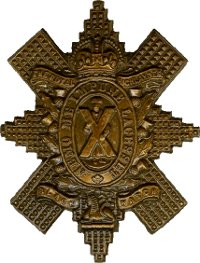 42ND BATTALION, (5TH ROYAL HIGHLANDERS OF CANADA).
42ND BATTALION, (5TH ROYAL HIGHLANDERS OF CANADA).
42nd Battalion (5th Royal Highlanders of Canada) Canadian Expeditionary Forces (Lieut Colonel G.C. Cantlie) joined the Brigade on its formation at Mont-des-Cats, having been for a period of nearly three months on Active Service in France. Recruited and mobilized in the City of Montreal, Province of Quebec in February 1915, and after five months training in Canada sailed for England, where further training in musketry was undergone until the 9th October 1915 when the Battalion came over to France.
The 42nd Canadian Infantry Battalion is now perpetuated by The Black Watch of Canada (Royal Highland Regiment).
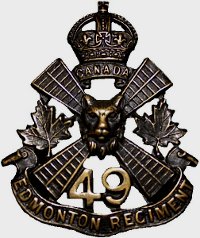 49th BATTALION (CANADIANS).
49th BATTALION (CANADIANS).
The 49th Battalion (Lieut Colonel W.A. Griesbach) mobilized in Edmonton, Alberta, the majority of the members of the Battalion being railway men, miners and farmers – about 35% being Canadian and the remainder British born, and recruited from the Northern portion of the Province, from Edmonton Peace River District and the vast territory north and west of the Capital City of the Province, a large percentage of the men being of Scotch descent.
The 49th Canadian Infantry Battalion is now perpetuated by The Loyal Edmonton Regiment (3rd Bn, Princess Patricia's Canadian Light Infantry).
The Brigade being composed as it is of well disciplined and seasoned troops there seems no reason why it should not be able in a short while to hold its own with the other Brigades of the Canadian Expeditionary Forces. All feel that the good opinion already formed after a careful inspection of the units, will not be misplaced, and that when the records of this campaigns are written, the 7th Canadian Infantry Brigade, will not have failed to carry out its duties in a sound soldierly manner.
![]() Follow The Regimental Rogue on facebook.
Follow The Regimental Rogue on facebook.
| « | April 2013 | » | ||||
| S | M | T | W | T | F | S |
| 1 | 2 | 3 | 4 | 5 | 6 | |
| 7 | 8 | 9 | 10 | 11 | 12 | 13 |
| 14 | 15 | 16 | 17 | 18 | 19 | 20 |
| 21 | 22 | 23 | 24 | 25 | 26 | 27 |
| 28 | 29 | 30 | ||||